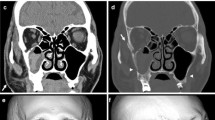Abstract
Nasal bone fracture is the most common fracture which would result from facial trauma. So, the present study performed to select the most reliable way to diagnose new fractures considering CT scan results as a gold standard in this matter. All the people refer to a forensic medicine center were, at first, physically examined by general practitioners. Plain lateral radiography and ENT consult were requested afterwards. CT scan was requested to get trusty results in case of any imbalance between Radiographic finding and physical examination. The results finally were evaluated and compared. CT scan was tried for 61 (6%) patients with positive clinical findings for new fracture which were not supported by radiologic studies. New fracture was identified in 55 participants out of the above number. Trusting physical examination and its preference to the radiologic findings has special value in cases where fracture is not detectable by radiography and there is no access to CT scan.
Similar content being viewed by others
References
Thiede O, Krömer JH, Rudack C, Stoll W, Osada N, Schmäl F (2005) Comparison of ultrasonography and conventional radiography in the diagnosis of nasal fractures. Arch Otolaryngol Head Neck Surg 131:434–439
Alvi A, Doherty T, Lewen G (2003) Facial fractures and concomitant injuries in trauma patients. Laryngoscope 113:102–106
Dibaie A, Raissian Sh, Ghafarzadeh S (2009) Evaluation of maxillofacial traumatic injuries of forensic medical center of Ahwaz, Iran, in 2005. Pak J Med Sci 25:79–82
Rhee SC, Kim YK, Cha JH, Kang SR, Park HS (2004) Septal fracture in simple nasal bone fracture. Plast Reconstr Surg 113:45–52
Nigam A, Goni A, Benjamin A, Dasgupta AR (1993) The value of radiographs in the management of the fractured nose. Arch Emerg Med 10:293–297
Kwon TK, Cha JH, Kim YW et al (1995) The role of ultrasound in the diagnosis of nasal bone fracture. Kugler Publications Amsterdam, New York
Juhl JH, Crummy AB, Kuhlman JE et al (2009) Essentials of radiologic imaging, 7th edn. JB Lippincott Co, Philadelphia
Haaga JR, Alfidi RJ (2009) Computed tomography of the whole body, 3rd edn. C. V. Mosby, Washington, DC
Cummings CW (2005) Otolaryngology head and neck surgery, 4th edn. C.V. Mosby, Washington, DC
Chen W, Lu X (1999) Diagnosis and restitution of nasal bone fracture. Lin Chuang Er Bi Yan Hou Ke Za Zhi 13:68–69
Rhee SC, Kim YK, Cha JH, Kang SR, Park HS (2004) Septal fracture in simple nasal bone fracture. Plast Reconstr Surg 114:1357–1358
Oluwasanmi AF, Pinto AL (2000) Management of nasal trauma—widespread misuse of radiographs. Clin Perform Qual Health Care 8:83–85
Smith JE, Perez CL (2008) Nasal Fractures. Medscape . Available at: http://emedicine.Medscape.com Accessed 20 Dec 2009
Mayorga O, Steele N, Fried M (2006) Nasal Fracture Reduction. Emedicine. Available from http://www.emedicine.com/proc/topic82831.htm
Acknowledgments
The authors are indebted to Farzan Institute for Research and Technology for technical assistance.
Conflict of interest
None.
Author information
Authors and Affiliations
Corresponding author
Additional information
Key Message
Trusting physical examination and its preference to the radiologic findings has special value in cases where fracture is not detectable by radiography and there is no access to CT scan.
Rights and permissions
About this article
Cite this article
Gharehdaghi, J., Samadi Rad, B., Ghatreh Samani, V. et al. Comparison of Physical Examination and Conventional Radiography in Diagnosis of Nasal Fracture. Indian J Otolaryngol Head Neck Surg 65 (Suppl 2), 304–307 (2013). https://doi.org/10.1007/s12070-011-0453-x
Received:
Accepted:
Published:
Issue Date:
DOI: https://doi.org/10.1007/s12070-011-0453-x




